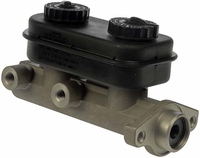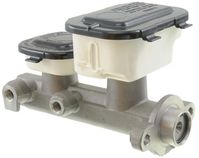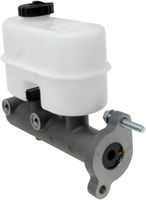Sweeting Performance - Bosch Hydro-Boost®, Bosch Hydro-Max®, Vacuum, and Air-Hydraulic Power Brake Boosters, Master Cylinders, and Accessories
Wilwood Combination Proportioning Valve
Product Description
3/8-24 IF inlet and outlet
GENERAL INFORMATION: • Simplifies mounting, fluid circuit plumbing, brake light wiring, and brake bias adjustments on modified, custom built, or competition vehicles equipped with brake system upgrades
• Maintains full separation between the front and rear fluid circuits when used with tandem outlet or dual mount master cylinder assemblies.
• Bias proportioning adjustment is provided in the rear fluid circuit.
• The front circuit has a single inlet and two outlets for optional line routing.
• A fluid port with a pressure switch responds instantly to pressure in the front fluid circuit for brake light activation. A wiring pigtail with a protective boot is included with the switch. NOTE: Although the combination valve may mount in some OEM locations, it is not a direct replacement for any OEM unit and may require modifications to the brake lines and/or the mounting location for installation. Bias proportioning adjustments will be specific to each vehicle.
INSTALLATION INSTRUCTIONS: Mounting: If equipped, the OEM combination valve bracket may provide the ideal mounting location for the combination valve. Otherwise, position the Wilwood Adjustable Combination Proportioning Valve in a convenient location in close proximately to the master cylinder(s) using customer supplied hardware or a fabricated bracket.
Line Connections: The line connections on the Wilwood combination valve are 3/8-24 with an SAE inverted flare for standard 3/16” (-3) brake line. The supplied tube nuts can be double flared onto any 3/16” brake line. However, if your lines are already flared with 3/8-24 fittings, then the tube nuts are not necessary.
1. The line from the master cylinder for the front brakes connects to the port marked “FI”, (front in), on the top of the combination valve, refer to Figure 1.
2. The two ports on the bottom of the valve marked “FO”, (front out), will be the supply lines to the front calipers. These ports can be used to run individual lines to each caliper. Or if preferred, one port can be blocked, and a single line run from either “FO” port to a “T” plumbed downstream, splitting the lines to feed each front caliper. The function of the valve will not change.
3. The line from the master cylinder for the rear brakes connects to the port marked “RI”, (rear in), on the top of the proportioning valve.
4. The single port marked “RO”, (rear out), connects to the line going to the back of the car to feed the rear calipers. NOTE: Tube wrenches are always preferred for tightening the fittings.
Swtch Connections: If your vehicle is already equipped with a brake light switch on the brake pedal, the switch in the combination valve does not need to be used, and it may be removed. Plug the unused port with a 1/8-27 NPT pipe plug (not included). For all other applications, or if you wish to eliminate the switch on the brake pedal, use the switch in the proportioning valve block.
1. Before connecting the lead wires, cut the ends (that do not have the clip) on a 45° angle. Coat both cut ends with Dielectric Grease to ease slidingthewiresthroughtheholesinthedustboot. Slidetheclipsonto the spade connectors and cover with the dust boot.
2. Connect one lead of the brake light pressure switch to a 12 volt, 15 amp fused circuit. This should be a battery direct, always hot circuit. Do not use an ignition key switch activated circuit.
3. Connect the other pressure switch wire to the lead wire going to the brake lights.
4. Be sure the brake lights are properly grounded, and all connections are secure and insulated.
Fluid: The Wilwood proportioning valve block is fully compatible with all types of brake fluid including DOT 3, 4, 5, and 5.1 fluids. DOT 3, 4 and 5.1 fluids are fully miscible, but DOT 5 silicone fluid should never be mixed with any other fluids. Always follow the vehicle manufacturers fluid recommendations for any vehicle. A complete flush and fill with fresh fluid is recommended for all installations. For best performance, use Wilwood Hi-Temp 570, EXP 600 Plus, or Wilwood FIVE DOT 5 high performance fluids.
Bleeding: To properly bleed the brake system, begin with the caliper farthest from the master cylinder. For fixed mount calipers with two bleed screws on top, bleed the outboard bleed screw first, then bleed the inboard screw. Repeat this procedure until all calipers have been bled, ending with the caliper closest to the master cylinder. Once the system has been bled, the pedal should maintain a consistent, firm feel. If the pedal returns to a spongy feel after it has rested from the bleeding process, this is an indication that air still exists in the system. If this occurs, repeat the bleeding process until all air has been purged and the pedal retains a firm feel. NOTE: When installing a new master cylinder, it is important to follow proper bench bleeding procedures. Follow the installation instructions provided with the new master cylinder. If a firm pedal can not be achieved after bleeding the system, the master cylinder may not be properly sized for the brake system.
Proportioning Valve Adjustment: The proportioning valve is used to adjust the rate of increase in rear brake line pressure, relative and proportionate to the increase in front brake line pressure. For safety and performance, the rear brakes should never lock before the front brakes. Otherwise, an out of control situation could occur.
1. Begin with the valve in the full proportioned (least pressure) position by turning the knob all the way out (counter-clockwise rotation).
2. In a safe location, make several hard stops from 30 MPH observing the function of the rear brakes. If the rear brakes do not lock up before the front, gradually increase the rear line pressure by rotating the valve clockwise (two turns each time).
3. Continue these adjustments until the maximum amount of rear brake pressure can be achieved, and no wheel rear lock is observed. 4. Test the vehicle again at 50 MPH and make any additional adjustments as needed.
GENERAL INFORMATION: • Simplifies mounting, fluid circuit plumbing, brake light wiring, and brake bias adjustments on modified, custom built, or competition vehicles equipped with brake system upgrades
• Maintains full separation between the front and rear fluid circuits when used with tandem outlet or dual mount master cylinder assemblies.
• Bias proportioning adjustment is provided in the rear fluid circuit.
• The front circuit has a single inlet and two outlets for optional line routing.
• A fluid port with a pressure switch responds instantly to pressure in the front fluid circuit for brake light activation. A wiring pigtail with a protective boot is included with the switch. NOTE: Although the combination valve may mount in some OEM locations, it is not a direct replacement for any OEM unit and may require modifications to the brake lines and/or the mounting location for installation. Bias proportioning adjustments will be specific to each vehicle.
INSTALLATION INSTRUCTIONS: Mounting: If equipped, the OEM combination valve bracket may provide the ideal mounting location for the combination valve. Otherwise, position the Wilwood Adjustable Combination Proportioning Valve in a convenient location in close proximately to the master cylinder(s) using customer supplied hardware or a fabricated bracket.
Line Connections: The line connections on the Wilwood combination valve are 3/8-24 with an SAE inverted flare for standard 3/16” (-3) brake line. The supplied tube nuts can be double flared onto any 3/16” brake line. However, if your lines are already flared with 3/8-24 fittings, then the tube nuts are not necessary.
1. The line from the master cylinder for the front brakes connects to the port marked “FI”, (front in), on the top of the combination valve, refer to Figure 1.
2. The two ports on the bottom of the valve marked “FO”, (front out), will be the supply lines to the front calipers. These ports can be used to run individual lines to each caliper. Or if preferred, one port can be blocked, and a single line run from either “FO” port to a “T” plumbed downstream, splitting the lines to feed each front caliper. The function of the valve will not change.
3. The line from the master cylinder for the rear brakes connects to the port marked “RI”, (rear in), on the top of the proportioning valve.
4. The single port marked “RO”, (rear out), connects to the line going to the back of the car to feed the rear calipers. NOTE: Tube wrenches are always preferred for tightening the fittings.
Swtch Connections: If your vehicle is already equipped with a brake light switch on the brake pedal, the switch in the combination valve does not need to be used, and it may be removed. Plug the unused port with a 1/8-27 NPT pipe plug (not included). For all other applications, or if you wish to eliminate the switch on the brake pedal, use the switch in the proportioning valve block.
1. Before connecting the lead wires, cut the ends (that do not have the clip) on a 45° angle. Coat both cut ends with Dielectric Grease to ease slidingthewiresthroughtheholesinthedustboot. Slidetheclipsonto the spade connectors and cover with the dust boot.
2. Connect one lead of the brake light pressure switch to a 12 volt, 15 amp fused circuit. This should be a battery direct, always hot circuit. Do not use an ignition key switch activated circuit.
3. Connect the other pressure switch wire to the lead wire going to the brake lights.
4. Be sure the brake lights are properly grounded, and all connections are secure and insulated.
Fluid: The Wilwood proportioning valve block is fully compatible with all types of brake fluid including DOT 3, 4, 5, and 5.1 fluids. DOT 3, 4 and 5.1 fluids are fully miscible, but DOT 5 silicone fluid should never be mixed with any other fluids. Always follow the vehicle manufacturers fluid recommendations for any vehicle. A complete flush and fill with fresh fluid is recommended for all installations. For best performance, use Wilwood Hi-Temp 570, EXP 600 Plus, or Wilwood FIVE DOT 5 high performance fluids.
Bleeding: To properly bleed the brake system, begin with the caliper farthest from the master cylinder. For fixed mount calipers with two bleed screws on top, bleed the outboard bleed screw first, then bleed the inboard screw. Repeat this procedure until all calipers have been bled, ending with the caliper closest to the master cylinder. Once the system has been bled, the pedal should maintain a consistent, firm feel. If the pedal returns to a spongy feel after it has rested from the bleeding process, this is an indication that air still exists in the system. If this occurs, repeat the bleeding process until all air has been purged and the pedal retains a firm feel. NOTE: When installing a new master cylinder, it is important to follow proper bench bleeding procedures. Follow the installation instructions provided with the new master cylinder. If a firm pedal can not be achieved after bleeding the system, the master cylinder may not be properly sized for the brake system.
Proportioning Valve Adjustment: The proportioning valve is used to adjust the rate of increase in rear brake line pressure, relative and proportionate to the increase in front brake line pressure. For safety and performance, the rear brakes should never lock before the front brakes. Otherwise, an out of control situation could occur.
1. Begin with the valve in the full proportioned (least pressure) position by turning the knob all the way out (counter-clockwise rotation).
2. In a safe location, make several hard stops from 30 MPH observing the function of the rear brakes. If the rear brakes do not lock up before the front, gradually increase the rear line pressure by rotating the valve clockwise (two turns each time).
3. Continue these adjustments until the maximum amount of rear brake pressure can be achieved, and no wheel rear lock is observed. 4. Test the vehicle again at 50 MPH and make any additional adjustments as needed.



























